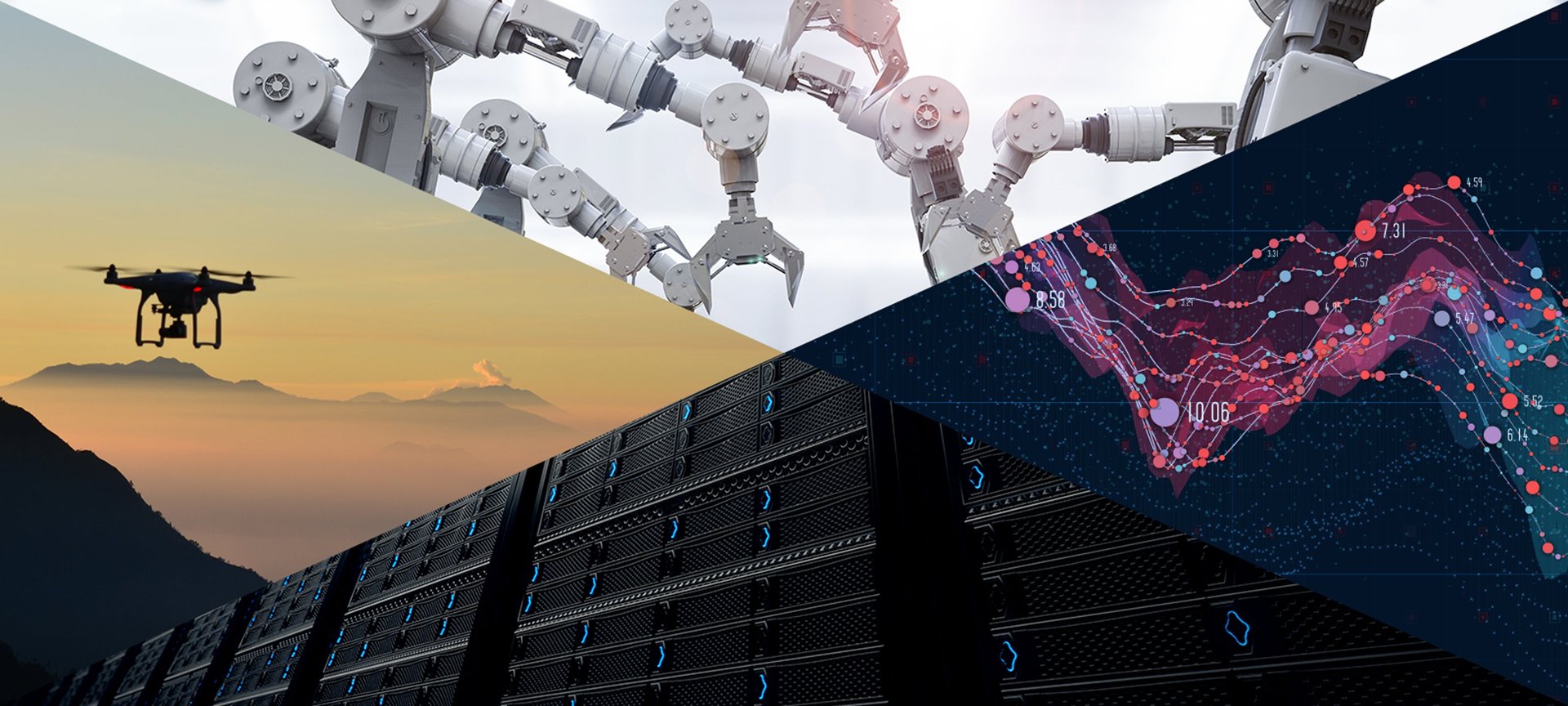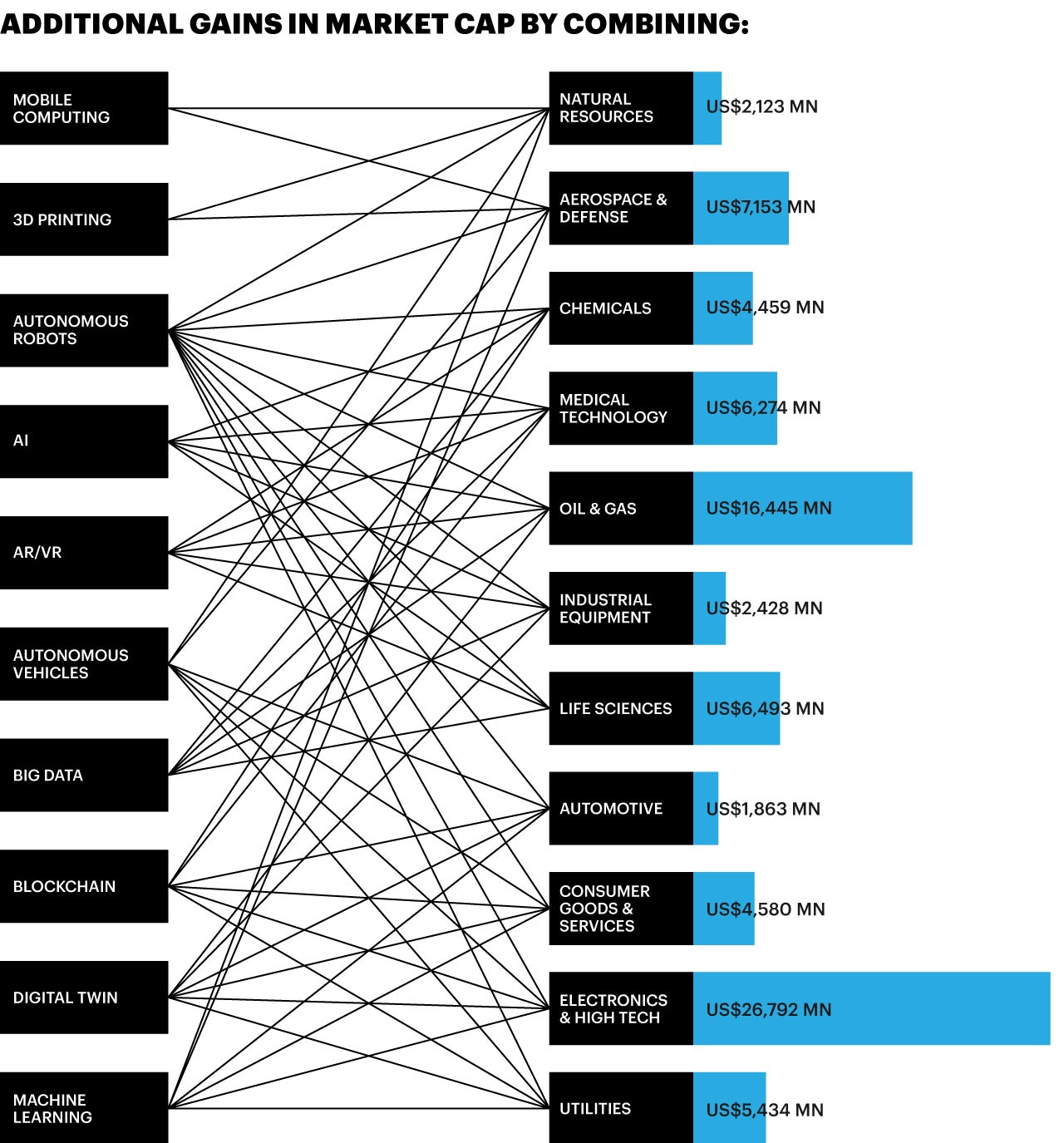Do the math: What happens when you add the next big thing to the next big thing?
It’s no secret that today’s digital landscape looks wildly different than that of 10 years ago. Terms like “blockchain” and “biometrics”—once hypotheticals relegated to science fiction and fringe subreddits—have entered mainstream vernacular. True to Moore’s Law of exponential progress, such innovation is disrupting today’s market—and zeitgeist—at breakneck speeds. With everything from agriculture to aeronautics in the midst of paradigm shift, a cautious approach to adopting new technologies simply can’t keep pace.


It’s no secret that today’s digital landscape looks wildly different than that of 10 years ago. Terms like “blockchain” and “biometrics”—once hypotheticals relegated to science fiction and fringe subreddits—have entered mainstream vernacular. True to Moore’s Law of exponential progress, such innovation is disrupting today’s market—and zeitgeist—at breakneck speeds. With everything from agriculture to aeronautics in the midst of paradigm shift, a cautious approach to adopting new technologies simply can’t keep pace.
Nor will adopting just one innovation suffice. Effective adaptation almost always involves a combination of innovations working together: a dash of machine learning here, a sprinkle of automation there. As Accenture Chief Strategy Officer Omar Abbosh describes: “You’re combining a series of innovations, one on the back of the next, to do something fundamentally different… You’ve all heard about Big Data and artificial intelligence and internet of things… They are all very meaningful in their own right, but when they come together they can have a massive impact on business and society.”
The benefits of combination abound. For example, amalgamating just five technologies—autonomous robots, AI, 3D printing, big data, and blockchain—could save industrial-equipment companies a total of $1.6 billion.
Consider what buying eggs could look like in the future: A smart fridge senses you’re running low on eggs based on your learned omelet-eating habits. The fridge automatically orders eggs for delivery, which is sent by cloud on a secure blockchain. A grocery bot uses RFID to remotely find your favorite eggs, which are then dispatched by autonomous drones via an optimal air route determined by extensive data analysis. It’s a frittata of buzzwords and savings.
The perfect recipe of cutting-edge innovations will vary by industry, but synergies are consistently cost-reducing.

So what’s a fitting innovation blend for your industry? Though any invention’s custom integration can be complex in abstract, envisioning their real-world potential can be almost arithmetical. Below, we describe some of our favorite formulas already shaping our future.
360 cameras + drones + AI + cloud computing = autonomous aerial inspection
In industries ranging from agriculture to emergency services to insurance, commercial-grade drones equipped with high-resolution cameras are already revolutionizing inspection. Since 2013, drone startups have raised $1.5 billion in funding. The potential for increased automation and nimbler hardware at increasingly attractive price-points is making affordable aerial surveillance a lucrative reality.
In the near future, aerial inspection will look even more impressive: synchronized drone fleets grabbing high-definition, 360-degree video footage, feeding data to cloud-based platforms for analysis, and updating directives—distributing pesticides, alerting farmers to threats—in the blink of an eye. Not only do these systems put people out of harm’s way, they also bolster worker efficiency: Farmers can cover greater ground, live-monitor crops, and provide real-time response in the event of fires or drought.
NLP + blockchain = smart contracts
Blockchain dominated 2017’s “disruption” conversation. The decentralized digital ledger is touted as virtually incorruptible and innately transparent, making it an apt platform business transactions, contracts, and record-keeping.
When combined with natural language processing (NLP)—the ability for a computer to recognize and process human language data—blockchain is particularly potent. With NLP, information can be written and interpreted without a human. The combination of blockchain and NLP has widespread implications for the future of legal agreements. Self-writing smart contracts will make exchanges of money, property, shares—anything of value, really—seamless, safe, and more cost-effective.
AI + biometrics = precision medicine
In just a few years, the AI health market is projected to grow 10-fold. The applications of AI in healthcare are almost endless: robot-assisted surgery, virtual nursing assistants, dosage control, automated workflow administration, etc. And while robot-assisted surgery has high immediate value potential ($40 billion), we’re only just scratching the surface of any even bigger area: intelligent diagnostics and precision therapy.
AIs get smarter when provided lots and lots of high quality data. And as biometrics get better at collecting data (with pill-size cameras, fitness bracelets, gene expression analysis, etc.) and healthcare software systems get better at organizing and analyzing data, we’re due for a revolution in how diseases are identified and treated. Health AI can compare your personal health to an extensive database, comparing genetics, comorbidities, environment, and behavior, and then optimize and improve treatments based on what’s worked previously given your personal situation.
A similar machine learning process can be applied to health research. From clinical trial selection to pharmaceutical modelling to epidemic outbreak prediction, AI augments the tireless work of all types of healthcare professionals, saving money and lives.
3D printing + machine learning + robotics = adaptive manufacturing
As robots do more heavy-lifting and as 3D printers produce components cheaply and at scale, many manufacturers have been quick to redesign their factories. But manufacturing also stands to gain a lot from machine learning, which can optimize supply chains, help reduce waste by intelligently managing material flow (in the US, building-related waste due to mismanagement of materials costs over $160 billion every year).
An especially interesting case is that of a company that is 3D-printing a special alloy bridge. The company’s industrial robots have sensors that detect location, pattern, and strength of welds. By combining weld data with machine-learning algorithms, they’ll be able to quickly print custom bridges that design themselves based on learned adaptations. The result: stronger, safer infrastructure.
The sum of it all: Industry X.0
Of course, digital convergence is less a game of simple addition and subtraction as it is a complete system reconfiguration. Established organizations will need to master the tightrope act of growing the core of their companies while scaling for new business models. Accenture has a phrase for this delicate balance: “Industry X.0.” The idea encompasses how everything from consumer transactions to production chains are undergoing fundamental changes—and how human ingenuity plays an integral role.
And that’s where a final step of arithmetic comes into play: the human capital multiplier. From the wheel to the web, technology has always made work easier, freeing people to focus on more ambitious, more interesting challenges. In spite of rising automation, none of these combinations will see their full potential if companies don’t also invest in the designers, thinkers, and engineers that dream of and deliver innovation. People are the force and source of Industry X.0.
As innovative technologies continue to shape the future of business and greater society, it’s clear we are living in a world in which almost anything that can be imagined can become reality—given the right equation.
Learn more about 2018’s next big thing at Accenture’s panel discussion with Quartz’s Kevin Delaney at the Davos World Economic Forum.
This article was produced on behalf of Accenture by Quartz Creative and not by the Quartz editorial staff.